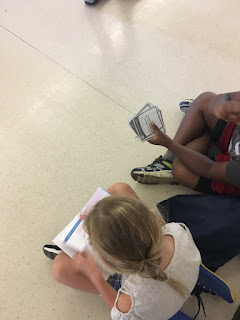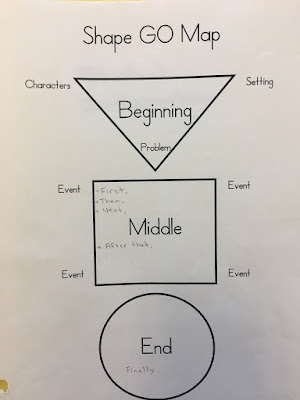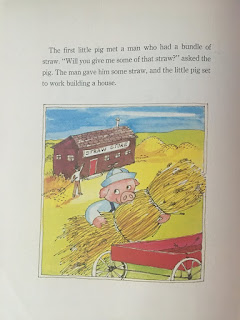A reminder to donate to St. Rita’s annual Thanksgiving Food Drive to
support families in need at the Debra Dynes House. Canned food and
non-perishable food items are being accepted at our school until
Wednesday October 9th. Please think globally and, if you can, act locally
to support those who need assistance.
Updates of the week:
Terry Fox Walk was a success:
Classifying animals in Science:
Math Support
A summary of key ideas the grade 2's are learning in math:
You could use this to support your child's work. There are suggestions for simple activities you can do with your child.
COUNTING FORWARD:
Counting by 1s
The foundation of number work is counting. In order to count actual objects, students first need to know the counting words.
The intention, over the course of the full year — not in one lesson — is to build students’ capacity to count to 200.
Helping students recognize patterns is key to improving their comfort with the counting sequence.
To learn the numbers 1 to 12, students must simply learn the words.
•
|
The patterns begin in the teen numbers. Students must learn new words for 13 and 15 (“thirteen” and “fifteen”). All the others are pronounced with a “four,” “six,” “seven,” “eight,” and “nine” to make “fourteen,” “sixteen,” “seventeen,” “eighteen,” and “nineteen.”
|
•
|
After students know the words for 20, 30, 40, 50, 60, 70, 80, and 90, they can use more patterns to count all the way to 99.
|
•
|
100 has to be learned separately. Then the patterns used to count from 1 to 99 can be used again to count from 101 to 199, simply by adding “one hundred” at the beginning.
|
It is important that students eventually learn to count by 1s from any number less than 200.
The 100-chart and 200-chart are two key tools for helping students notice patterns.

Counting by 2s
When students say the words “two, four, six, …” up to 100, they are not counting objects but simply saying number words in a particular sequence.
When students are comfortable counting to 20 by 2s, counting can be extended to 30, 40, and beyond.
The dominant pattern when counting by 2s is to say numbers ending in “two, four, six, eight” and then the next “ten word” each time.
A 100-chart can help students see that when they count by 2s, they skip every second number that they would say if they were counting by 1s.

Students should have opportunities to begin counting at any multiple of 2, not just 2, for example, 18, 20, 22, … or 104, 106, 108, … . Grade 2 students are not expected to count by 2s starting with an odd number, although some students can do that.
Counting by 5s
As with counting by 1s and 2s, students do not count objects when they count by 5s in this lesson. They simply follow a pattern; that is, they say every fifth number (“5, 10, 15, 20 …”) up to 200.
Students might notice that, when counting by 5s, you say “_____-five,” then the next ten word, and then repeat, for example, 25 (ending in five), 30 (a ten word), 35 (ending in five), 40 (a ten word), and so on.
When students are comfortable counting to 20 by 5s, counting can be extended to 30, 40, and beyond, following the pattern.

A 100-chart or a 200-chart can help students see that you repeatedly skip four numbers when counting by 5s.
Students should have opportunities to begin counting at any multiple of 5, not just 5. For example, 75, 80, 85, … or 110, 115, 120, … .
Counting by 10s
When counting by 10s, the patterns begin with 20. All ten words 20 and higher end with the suffix “-ty.” Students must learn new words for 20, 30, and 50 (“twenty,” “thirty,” and “fifty”). All the others are pronounced with “four,” “six,” “seven,” “eight,” and “nine” to make “forty,” “sixty,” “seventy,” “eighty,” and “ninety.”
Students might notice that when they count by 10s, they skip nine numbers, say the tenth number, and then repeat.
Students should have opportunities to count by 10s starting at any multiple of 10, not just 10. For example, 40, 50, 60, … .
Counting by 25s
When Grade 2 students learn to count by 25s, they say the four numbers of the sequence up to 100 (“twenty-five, fifty, seventy-five, one hundred”), and then repeat the pattern to 200 (“one hundred twenty-five, one hundred fifty, one hundred seventy-five, two hundred”).
Helping Your Child
There are many opportunities in casual situations or while waiting for an event to start where you can encourage your child to count forward and extend a count just by asking, “Can you go higher?”
Be aware that many children find it difficult at first to “cross over” to the next group of 10. For example, counting from 29 to 30 is more difficult than counting from 23 to 24. Be attentive to when your child is ready for crossing from one decade to another, for example, moving from the twenties (29) to the thirties (30).
You can use 100-charts or 200-charts to help your child notice patterns. You can use a printed version or one you find online.
When your child is comfortable counting by 1s, encourage skip counting by 2s, 5s, 10s, and 25s. You can use the phrases “count by 2s,” “count by 5s,” and so on.
Definitions
count by 1s: to count by saying every whole number in order, for example, 1, 2, 3, …
count by 2s: to count by skipping numbers and saying every second number, for example, 2, 4, 6, …
count by 5s: to count by skipping numbers and saying every fifth number, for example, 5, 10, 15, …
count by 10s: to count by skipping numbers and saying every tenth number, for example, 10, 20, 30, …
count by 25s: to count by skipping numbers and saying every twenty-fifth number, for example, 25, 50, 75, …
100-chart: a 10-by-10 grid showing the counting numbers to 100 in rows of 10
200-chart: a 10-by-20 grid showing the counting numbers to 200 in rows of 10
number line: a line on which numbers are marked in sequence

number path: a counting tool in which each number in a series is contained within a cell, or rectangle

COUNTING BACKWARDS
Counting Back by 1s
In Grade 2, students learn to count back by 1s from 50.
It is easier to learn this skill in chunks in the following sequence:
3, 2, 1, then
5, 4, 3, 2, 1, then
10, 9, 8, … 1, then
20, 19, 18, … 1, then
30 (or 40 or 50) … 1, then
counting back from numbers like 32 and 47.
Counting Back by 10s
In Grade 2, students learn to count back by 10s from 100 or less. The skill develops quickly when
students realize that counting back by 10s is a matter of reducing the number of 10s (the 10s digit) by
1 with each count. It will be easier for most students to learn to count back by multiples of 10 before
learning to count back from other numbers (e.g., 61, 51, 41, …).
Students would probably find it helpful to practise counting up to 100 by 10s before learning about
counting back by 10s.
Helping Your Child
Help your child grasp that counting backwards means saying the numbers in reverse order.
So, 1, 2, 3 becomes 3, 2, 1 and 10, 20, 30 becomes 30, 20, 10.
Counting back by 10s is a little more complex than counting back by 1s. You can help your child see
that the 10s digit changes by just 1 every time. You can also point out that you are saying the
corresponding number in the previous row on a 100-chart.
Learning to count, either forward or backwards, involves being sure of the number sequences, which
can happen only with practice. Practice at home can be of enormous help.
You could incorporate counting into play to make practice interesting. For example, you could ask your
child to count backwards while helping a favourite toy hop backwards toward a finish line.
Another way to engage your child in counting back is to count back to events he or she is looking forward
to.
You could begin with countdowns like 3, 2, 1, and over time move the starting point higher.
Definitions
count back by 1s: to count in reverse order, saying every number, for example, 10, 9, 8, …
count back by 10s: to count in reverse order, saying every tenth number, for example, 100, 90, 80, …
digit: a single whole number that tells how many 1s, 10s, or 100s are in a number; for example, in 152,
we know there are 5 tens because the tens digit is 5


































